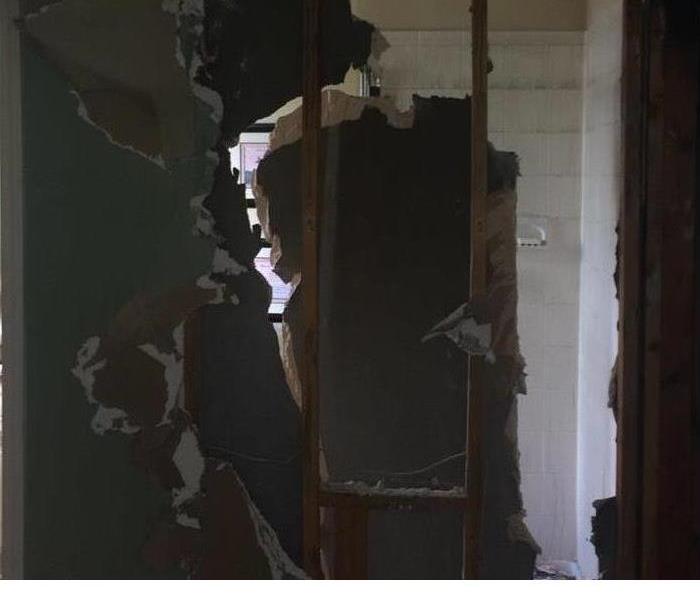Archived Fire Damage Blog Posts
3 Things to Consider When Buying An Extinguisher
12/21/2022 (Permalink)
Three Things to Think About When Purchasing an Extinguisher
Having a fire extinguisher in your Prairie Village, KS, home can help you stop a house fire from becoming a disaster. To best protect your home, you need to buy the right extinguisher for the space. You can turn to a residential fire damage professional and this guide to help you choose the best product for your needs.
1. Where Will It Be Used?
Are you going to put the extinguisher in your garage, kitchen, or laundry room? Believe it or not, the location of your extinguisher should actually dictate what product you buy. In the garage, for example, you may want a larger model because the home fire may grow before you notice it in this space. On the other hand, you may be able to use a smaller model in the kitchen where you'll typically spot fires before they grow out of hand.
2. What Kind of Flames Will It Fight?
Did you know that a fire extinguisher may be designed to fight a certain kind of flame? This safety equipment often comes labeled as A, B, or C. The A category works well against common combustibles, including cloth, wood, and paper. B extinguishers are often designed to tackle fires caused by cooking oils, gasoline, or other liquids. The C products may help with electric fires. As you purchase your tool, you need to think about the kind of fires that may take place in the room you want to keep it in.
3. How Easy Is It To Use?
Will anyone be able to use the extinguisher? A big part of fire preparedness is making sure everyone in your home can tackle an emergency situation. Purchasing an extinguisher that has an easy-to-use hose may make it easier for anyone in your family to dampen flames. It may be a good idea for you to include a how-to demonstration during your next family fire drill.
Having at least one fire extinguisher in your home is a great safety practice. Getting the best product for your space can increase the safety tool's usefulness.
How To Rid Your Home of Smoke Smells
10/28/2022 (Permalink)
How to Get Rid of Smoke Odors in Your Home
After a fire, your home will need some serious smoke cleaning to repair the damage. With a smell that intense, simply opening up the windows isn’t going to suffice. Professional odor remediation specialists in Overland Park, KS, can eliminate smoke odor in your home through the use of special techniques and equipment. Here are three examples of these techniques.
1. Air Filtration Devices
The most basic machine the professionals use is an industrial-strength version of the air purifiers you can buy at the store. An air filtration device with an activated carbon filter works by trapping odor molecules in the filter as the air flows through it. When these gases cannot escape, they deteriorate rapidly. The odor in the room is eventually neutralized.
2. Thermal Foggers
Thermal foggers use heat and deodorizing chemicals for the smoke cleaning process. They simulate the conditions that were present in the fire (i.e., heat and air pressure). Porous surfaces react to these conditions and absorb the deodorizers, just like they absorbed the smoke odor during the fire.
3. Ozone Machines
A third method for eliminating the smell of smoke in your home in Overland Park, KS, after a fire is through the use of ozone machines. Think of how the air smells outside right after it rains. The ozone machine mimics what nature does to purify the outside air. It produces molecules of ozone, also known as activated oxygen. The extra atom of oxygen in the ozone attaches to smoke particulates and breaks them down. After a while, the air smells fresh and clean because everything that was making it stink has been neutralized.
Smoke cleaning after a house fire involves more than just removing soot or smoke damage from the home or creating extra airflow. When you hire experts for odor remediation, they use equipment that actually eliminates the source of the smell so that it does not return.
3 Tips To Reduce the Risk of a Kitchen Fire
8/29/2022 (Permalink)
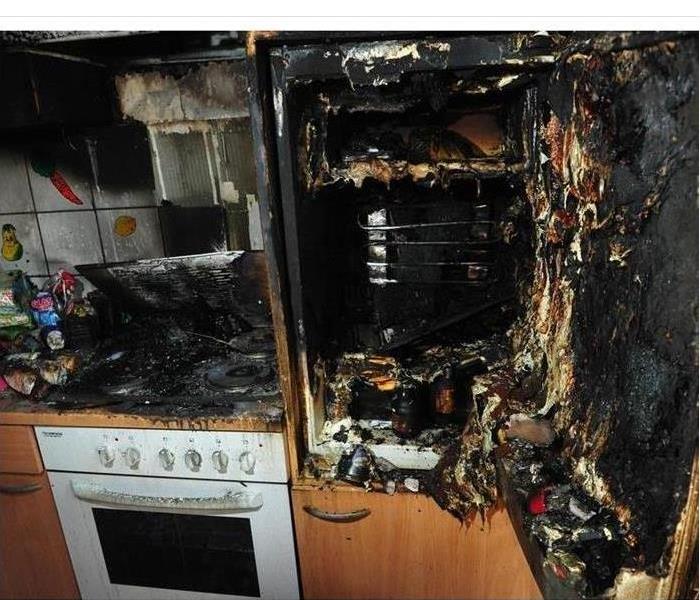 Kitchen fire in Leawood, KS
Kitchen fire in Leawood, KS
Three Tips That Will Help You Avoid A Fire While Cooking
Kitchen fires are the most common cause of house fires. Here are three helpful tips to help homeowners and residents avoid starting a fire while cooking and minimize the risks associated with kitchen appliances such as the cooktop or range in a home kitchen located in Leawood, KS.
1. Always Monitor Cooking Food
It is easy to lose track of time when you step away from the stove or oven. For this reason, it is advisable to make an effort to stay in the kitchen or delegate this responsibility the entire time you are cooking over an open flame. If you must leave the room, always set a timer that you can hear anywhere, and be sure to check back frequently.
2. Be Careful With Hot Oil
One of the most damaging types of kitchen fires is a grease fire. Many types of hot cooking oil can catch fire independently between 750 to 800 degrees Fahrenheit with a flashpoint around 600 degrees. One of the most important tips for putting out grease fires is to try dousing these extra-hot blazes with baking soda or salt or depriving the flames of oxygen with a metal pan or lid rather than using an extinguisher, which may cause the fire to spread.
3. Check Cooktops and Ranges
Homeowners should make sure that no combustibles such as cookbooks, loose-leaf printed recipes, or towels are stored too close to the stove. If flames shoot up or start to spread, the severity of fire damage will rapidly escalate if flammable items are nearby.
These tips address the leading causes of kitchen fires. Always practice fire safety by avoiding overloading circuits and identifying exposed wiring that could start an electrical fire at a home in Leawood, KS. Taking fire safety precautions has the potential to reduce personal safety risks and minimize the severity of fire damage.
3 Steps To Keep Your Pet Safe In a Fire
6/12/2022 (Permalink)
 Notify rescuers that you have pets inside your home with window clings.
Notify rescuers that you have pets inside your home with window clings.
Three Ways To Keep Your Pets Safe In the Event of a Fire
In emergencies, pets rely on their owners to protect them from harm. Taking preventative measures and coming up with a pet preparation plan will help pet owners in a fire. Be prepared for a fire emergency at your Prairie Village, KS, home and keep your pets safe by following the steps below.
1. Include Pets In Your Evacuation Plan
When making a plan for you to leave your home in the case of a fire, make sure your pets are a part of the evacuation. Decide who in your household is going to retrieve your pet, and practice escaping with your animals. Determine in advance where they will stay while you have professionals restore your home after the fire.
2. Ensure Pets Are Located In a Fire Emergency
Keep pets near an accessible entryway when you are not home. This will help firefighters locate your pet in the event of a rescue. Make sure your pet is wearing a collar with identification tags and that a leash is nearby, further helping officials safely remove your pet from a fire.
Additionally, you can notify rescuers that you have pets inside your home with window clings. The signs let firefighters know how many pets are inside the house, so they can make sure they are keeping all of your animals safe.
3. Protect Important Pet Documents
Store your pet’s vaccination records and any pet ownership documents in a firebox. In the event of a fire, your important paperwork will be kept out of harm’s way and can be retrieved after your home has been deemed safe.
Protecting your pets in a fire emergency is a priority for any pet owner. While you never want to put yourself in danger to rescue your animals, keep pet safety in mind when preparing in advance for a potential home fire.
Understanding Smoke Damage and Insurance
5/17/2022 (Permalink)
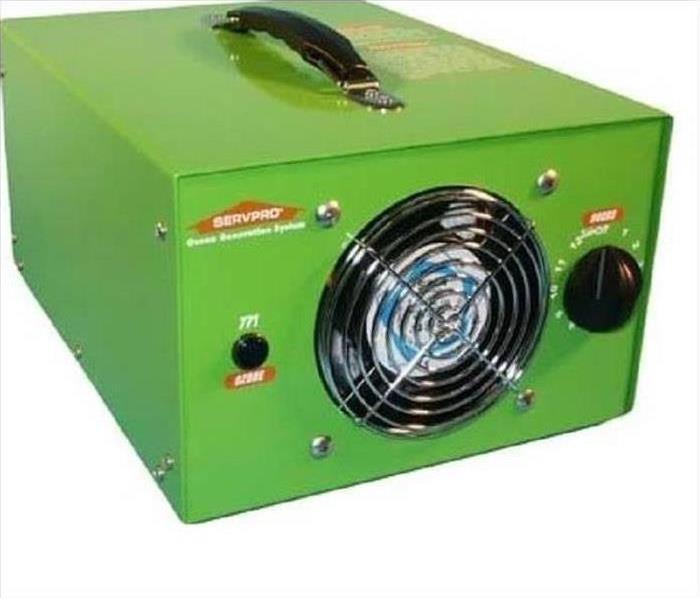 An ozone generator emits ozone gas that physically changes molecules and breaks them down.
An ozone generator emits ozone gas that physically changes molecules and breaks them down.
Smoke Damage and Insurance
While it may not be visible like soot damage, smoke damage is a strong, lingering issue. If your business is dealing with the issue, even if the fire was from a neighboring property, your commercial insurance will likely cover it, but it can be a tricky process.
Steps To Take
Once the damage is detected, there are essential steps that need to be taken to improve your chances of the claim being accepted and processed quickly.
Immediately contact your insurance provider. If you wait to report smoke damage, it may delay the claim and result in more downtime.
Have a clear understanding of your unique policy. Look over coverage, exclusions, deductibles, and filing requirements.
Document the damage by taking pictures and videos.
Maintain records of any expenses incurred due to the damage.
Contact a professional fire damage restoration company to have the damage assessed and a remediation plan set in motion.
Smoke Cleaning Methods
Since smoke odors are tricky, cleaning smoke requires industrial-grade tools and expertise. When choosing a certified restoration company, you get peace of mind that the air quality in your business will be restored. Three methods used to eliminate odors include:
Thermal Fogging: This is a heated deodorizer that neutralizes odors by attaching to smoke particles and absorbing them. It is an efficient way to ensure hard-to-reach areas are cleaned.
Ozone Generator: Used for decades, this generator emits ozone gas that physically changes molecules and breaks them down.
Hydroxyl Generator: Hydroxyl is gaining popularity because it breaks down particles and turns them into carbon dioxide and water, making it a people-friendly method.
If your business has sustained smoke damage, it is a problem that will linger if not properly treated. Immediately addressing the issue and working with your insurance and a restoration specialist makes it easier to get back to business.
How to Protect Your Personal Belongings From Fire Damage
4/26/2022 (Permalink)
Defend Your Personal Property Against Fire
Protecting your personal belongings from fire damage is crucial to ensure the safety of your home and your loved ones. Here are some tips to help you protect your personal belongings from fire damage:
Install smoke detectors and fire alarms: Smoke detectors and fire alarms are the first line of defense against fires. Make sure you have working smoke detectors and fire alarms in every room of your home, and test them regularly.
Keep flammable items away from heat sources: Keep flammable items like curtains, furniture, and paper products away from heat sources like fireplaces, heaters, and stoves.
Store flammable liquids properly: Flammable liquids like gasoline, lighter fluid, and paint thinner should be stored in a cool, dry place away from heat sources.
Use surge protectors: Use surge protectors to protect your electronics from electrical fires. Make sure you use surge protectors with built-in circuit breakers.
Have a fire extinguisher: Keep a fire extinguisher in your home and make sure you know how to use it. Make sure the fire extinguisher is easily accessible and up to date.
Create a fire evacuation plan: Have a fire evacuation plan in place in case of a fire. Make sure everyone in your household knows the plan and where to meet outside the home.
Invest in fire-resistant storage: Consider purchasing fire-resistant safes or storage containers for important documents and valuables.
Maintain your home: Regularly maintain your home to prevent fires. This includes cleaning out your dryer lint trap, inspecting electrical wiring, and having your chimney cleaned.
By following these tips, you can help protect your personal belongings from fire damage and ensure the safety of your home and family.
Fire Restoration Process
3/23/2022 (Permalink)
Fire Restoration Process
Fire restoration is a process that involves several steps to clean up and repair a property damaged by fire. The following is a general overview of the fire restoration process:
Emergency contact: The first step is to contact a professional fire restoration company. They will assess the extent of the damage and recommend the necessary actions.
Inspection and assessment: The fire restoration company will then inspect the property to assess the damage. They will identify the areas that need immediate attention and create a plan to restore the property.
Secure the property: If the property is not safe to enter, the restoration company will secure it to prevent further damage or theft.
Water removal: If water was used to put out the fire, the restoration company will remove the water and dry out the affected areas.
Smoke and soot removal: The restoration company will use specialized equipment to remove smoke and soot from surfaces, furniture, and belongings.
Cleaning and sanitizing: All affected surfaces, furniture, and belongings will be thoroughly cleaned and sanitized.
Repair and reconstruction: The restoration company will repair and reconstruct the damaged areas of the property. This may involve replacing drywall, flooring, and other building materials.
Final inspection: Once the restoration is complete, the restoration company will conduct a final inspection to ensure that the property is safe and fully restored.
Move-in: Once the property is safe and fully restored, you can move back in and resume your normal activities.
It is important to note that the fire restoration process can vary depending on the extent of the damage and the type of property. It is always best to hire a professional fire restoration company to ensure that the restoration is done correctly and safely.
3 Things To Consider When Buying an Extinguisher
12/21/2021 (Permalink)
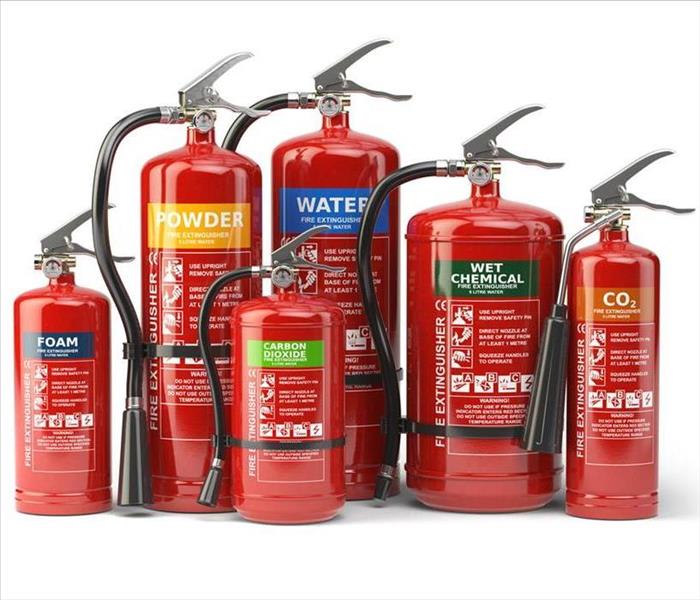 Having at least one fire extinguisher in your home is a great safety practice.
Having at least one fire extinguisher in your home is a great safety practice.
Three Things to Think About When Purchasing an Extinguisher
Having a fire extinguisher in your Prairie Village, KS, home can help you stop a house fire from becoming a disaster. To best protect your home, you need to buy the right extinguisher for the space. You can turn to a residential fire damage professional and this guide to help you choose the best product for your needs.
1. Where Will It Be Used?
Are you going to put the extinguisher in your garage, kitchen or laundry room? Believe it or not, the location of your extinguisher should actually dictate what product you buy. In the garage, for example, you may want a larger model because the home fire may grow before you notice it in this space. On the other hand, you may be able to use a smaller model in the kitchen where you'll typically spot fires before they grow out of hand.
2. What Kind of Flames Will It Fight?
Did you know that a fire extinguisher may be designed to fight a certain kind of flame? This safety equipment often comes labeled as A, B or C. The A category works well against common combustibles, including cloth, wood and paper. B extinguishers are often designed to tackle fires caused by cooking oils, gasoline or other liquids. The C products may help with electricity fires. As you purchase your tool, you need to think about the kind of fires that may take place in the room you want to keep it in.
3. How Easy Is It To Use?
Will anyone be able to use the extinguisher? A big part of fire preparedness is making sure everyone in your home can tackle an emergency situation. Purchasing an extinguisher that has an easy-to-use hose may make it easier for anyone in your family to dampen flames. It may be a good idea for you to include a how-to demonstration during your next family fire drill.
Having at least one fire extinguisher in your home is a great safety practice. Getting the best product for your space can increase the safety tool's usefulness.
15 - How To Rid Your Home of Smoke Smells
10/28/2021 (Permalink)
 Eliminate smoke odor from your home with an ozone machine.
Eliminate smoke odor from your home with an ozone machine.
How to Get Rid of Smoke Odors in Your Home
After a fire, your home will need some serious smoke cleaning to repair the damage. With a smell that intense, simply opening up the windows isn’t going to suffice. Professional odor remediation specialists in Overland Park, KS, can eliminate smoke odor in your home through the use of special techniques and equipment. Here are three examples of these techniques.
1. Air Filtration Devices
The most basic machine the professionals use is an industrial-strength version of the air purifiers you can buy at the store. An air filtration device with an activated carbon filter works by trapping odor molecules in the filter as the air flows through it. When these gases cannot escape, they deteriorate rapidly. The odor in the room is eventually neutralized.
2. Thermal Foggers
Thermal foggers use heat and deodorizing chemicals for the smoke cleaning process. They simulate the conditions that were present in the fire (i.e., heat and air pressure). Porous surfaces react to these conditions and absorb the deodorizers, just like they absorbed the smoke odor during the fire.
3. Ozone Machines
A third method for eliminating the smell of smoke in your home in Overland Park, KS, after a fire is through the use of ozone machines. Think of how the air smells outside right after it rains. The ozone machine mimics what nature does to purify the outside air. It produces molecules of ozone, also known as activated oxygen. The extra atom of oxygen in ozone attaches to smoke particulates and breaks them down. After a while, the air smells fresh and clean because everything that was making it stink has been neutralized.
Smoke cleaning after a house fire involves more than just removing soot or smoke damage from the home or creating extra air flow. When you hire experts for odor remediation, they use equipment that actually eliminates the source of the smell so that it does not return.
5 Candle Safety Tips
7/21/2021 (Permalink)
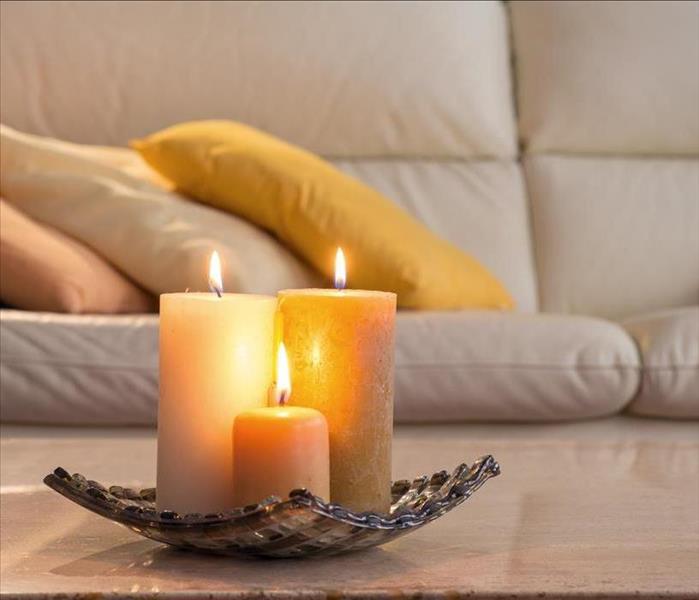 Situate candles with open flames at a safe distance from flammable materials.
Situate candles with open flames at a safe distance from flammable materials.
5 Safety Tips for Candles
Candles with open flames are a common cause of fires. Candle fires are most common during the holidays when more people use candles for decorative purposes. There are five safety tips that you can follow to reduce the risk of a candle fire in your home.
1. Limit candle use to the dining room table. Restricting the use of open-flame candles to the dinner table can help to ensure that more than one person watches lit candles. Be sure to blow out the candles when you clear the table.
2. Use candle alternatives in the bedroom. Bedrooms are the most common location for candle fires. People light candles and then fall asleep and leave them unattended. Try flameless alternatives for nighttime mood lighting.
3. Never leave children or pets unattended with a candle. Children or pets can easily play with candles and get hurt or knock over a lit candle and cause a candle fire.
4. Keep candles at least a foot away from combustibles. In addition to considering where a candle will look best, you should situate candles with open flames at a safe distance from flammable materials.
5. Try other mood lighting and fragrance solutions. From candle warmers that bring out the scent of your favorite candles without a fire risk to LED candles, there are more candle alternatives available today than ever before.
According to the National Fire Prevention Association, candles caused up to two percent of home fires and four percent of direct property damage between 2011 and 2015. Up to a third of these fires originated in bedrooms when the person who lit the candle fell asleep. A candle fire can put the lives of residents and the safety of your home at risk. If you do experience a fire, contact a residential damage restoration company in Prairie Village, KS that provides fire and smoke cleanup.
How To Select the Best Fire Extinguisher for Your Home
7/15/2021 (Permalink)
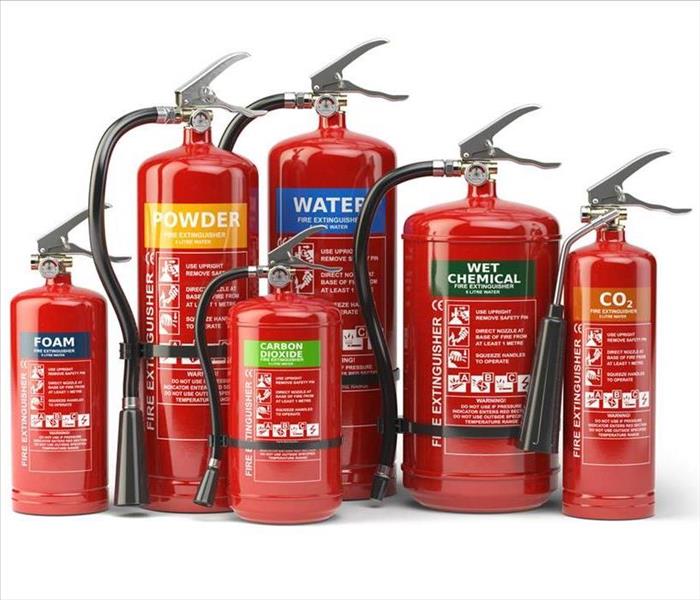 Not all fire extinguishers are created equal.
Not all fire extinguishers are created equal.
What Is The Best Type Of Fire Extinguisher For Home Use?
Not all fire extinguishers are created equal. When shopping for one for your home, it’s important that you understand the differences between each type of fire extinguisher, what they’re used for and how to select the right one for your home. There are a few factors to consider before making your purchase:
Size
There are four different sizes for extinguishers used to fight home fires: 10-pound, five-pound, two-pound, and stove-top. The 10-pound extinguisher is best for garages, sheds, and outbuildings in which a fire might have the potential to grow without being noticed.
A five-pound extinguisher is best for in the home and for combatting kitchen fires and electrical fires. If you want to be able to combat a home fire, the five-pound fire extinguisher is ideal.
A two-pound extinguisher is best for on-the-go, such as in a vehicle. These models are typically disposable and come with mounts to keep them from rolling around in the trunk.
Stove-top extinguishers are exactly what they sound like—extinguishers used to fight stove fires. They’re lightweight and can be mounted directly on the range hood for easy access.
Classification
Home extinguishers are labeled as either A, B or C. Models with an “A” are effective on ordinary combustibles such as paper, wood and cloth. Those with a “B” are ideal for flammable liquids such as oil or grease. Extinguishers with a “C” can be safely used on live electricity.
Use
Finally, you want to consider ease of use. An extinguisher won’t do you any good if you do not know how to use it or if you do not have the capacity to operate it. When shopping around, ask a technician for a demonstration or, at the very least, step-by-step instructions.
A fire extinguisher needs to be a part of your fire preparedness plan.
Home Fire Prevention: Are You Prepared?
5/24/2021 (Permalink)
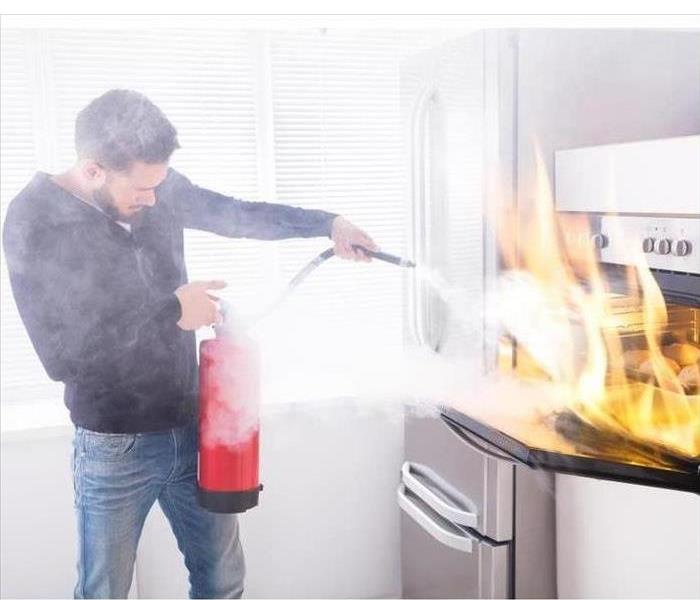 Kitchen fire in Leawood, KS.
Kitchen fire in Leawood, KS.
No one wants to think about a fire in their home, but fire preparedness is an essential element home safety. Fire services respond to nearly 400 thousand home fires each year. This discussion about common fire causes may help you augment your household’s fire-readiness plan.Kitchen Hazards
Building codes require a smoke alarm near the kitchen because nearly half of fires at home are cooking-related. Some common sources of kitchen fires include:
- Gas stove flames can ignite built-up oils or grease on pots and pans.
- An unlit gas burner accidentally left on can cause dangerous gas build-up in your kitchen.
- Greasy or dry food that is near a hot broiler coil can spark an oven fire.
- Small kitchen appliances, such as toasters, can ignite dry crumbs that contact the heating element.
Kitchen fires can cause significant damage and may require professional fire restoration. It is recommended to keep a fire extinguisher near the kitchen.
Human Carelessness
Fires caused by recreational activities, such as barbecuing or smoking, cause thousands of home fires yearly. It’s important to barbecue outside at a safe distance from structures. Following manufacturer’s instructions on cleaning and lighting your grill is essential. Smoking in the bedroom is a common cause of home fires. It is recommended that you not smoke while reclining or while using alcohol. Human error is another reason to keep a fire extinguisher in risk-prone areas.
Heating Appliances
Winter temperatures can make it tempting to heat your bedroom with a space heater before going to bed. An unattended small heater can spark a home fire; it may become overheated or tip over and ignite nearby drapes, carpet or clothing. If you turn a small heater on, it’s recommended you stay in the room throughout its operation.
Fires start because a flame or heating element comes in contact with some kind of fuel. This may be gas, textiles, grease, or oil. It’s important to carefully monitor anything with a heating element in your home. A wisely-located fire extinguisher can save your Leawood, KS, home from extensive damage. Common-sense fire preparedness can mean the difference between a relaxing evening and a devastating fire.
3 Steps to Prepare for the Perfect Dinner Party
3/25/2021 (Permalink)
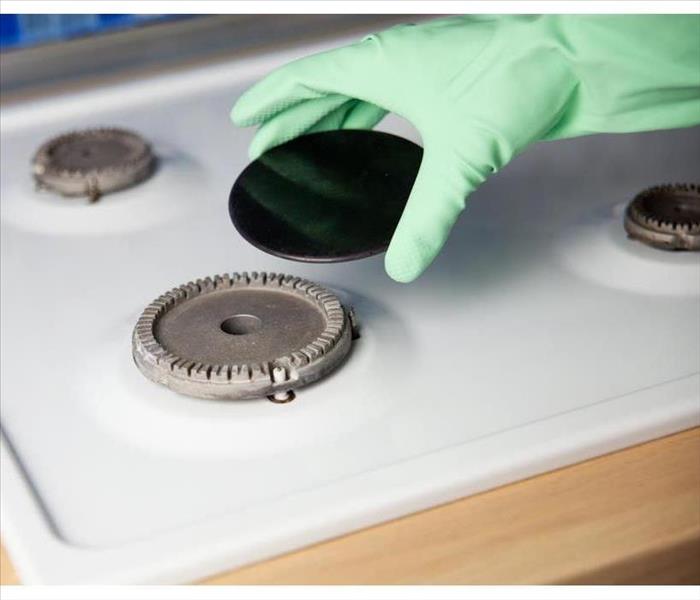 Keep your kitchen clean!
Keep your kitchen clean!
3 Steps to Prepare for the Perfect Dinner Party
If you are a seasoned dinner party host, you know the tricky balance of maintaining a clean kitchen while whipping up a delectable feast for a slew of family and friends. It's easy to get behind on one of these endeavors, resulting in a mediocre meal or an embarrassingly messy gas range. Make the focus your delicious food by following these easy steps to a clean, tidy kitchen.
1. Prep
Experienced chefs in Overland Park, KS, know the importance of cleaning the kitchen as they cook. This process eliminates the need for too much elbow grease post-meal, allowing more time for conversation. First, be sure to stock up on cleaning essentials before your next gathering:
- Vinegar
- Soap
- Rags
- A toothbrush
When utilizing your gas range to cook a meal, prepare the food ahead of time, cleaning all utensils and countertops that dirty along the way. Once cooked, place the hot food in heat-resistant containers, and keep them warm in the oven. This practice will allow for time to clean up before your guests' arrival.
2. Scrub
Once your dinner is complete and warming in the oven, begin your range cleaning process. Remove the grates from the stove, and spray the surface with a water and vinegar solution. If residue persists after wiping it clean, dip a toothbrush in some dish soap, and scrub the particles free. Finally, polish the grates and burner heads in warm soapy water until they are free from leftover particles. This action is critical, as remaining food fragments can burn on an ignited range, resulting in an unpleasant smoke smell.
3. Reassemble
Once all sections are clean and dry, reassemble your range. It is now tidy and presentable for company, and you have one less duty to perform after dinner. Use your clean stove to display hot food containers straight out of the oven. The grates can withstand heat, eliminating the need for any fire damage assessment at your dinner party!
Maintaining a clean kitchen as you cook makes any host's job simple and fun. Spead more time with your guests by cleaning your gas range before they arrive.
4 Steps for Using a Fire Extinguisher
10/31/2020 (Permalink)
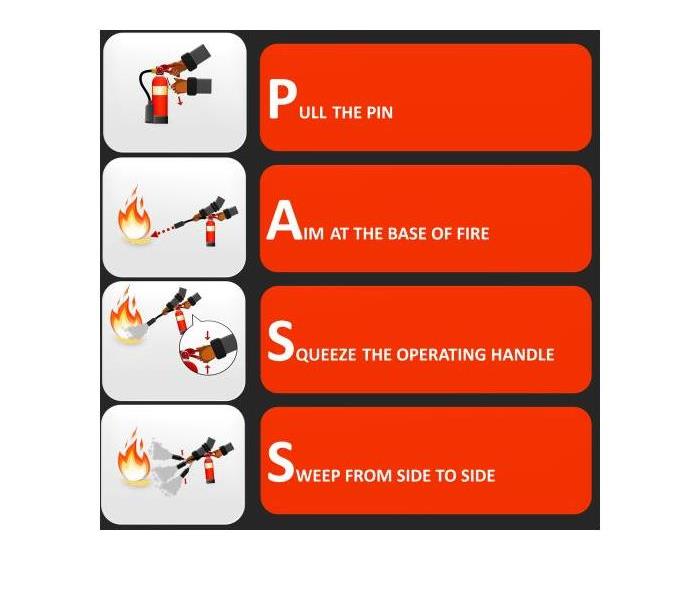 Use the P.A.S.S technique
Use the P.A.S.S technique
Follow These Steps To Extinguish A Small Fire
In the event of a fire in Leawood, KS, it is important that all staff and workers have been briefed on how to operate a fire extinguisher. There are several different types of extinguishers, but the basics are quite consistent across brands and models. Most can be readied in four simple steps.
1. Pull
For safety, all fire extinguishers have a pin built in to prevent accidental activation. There is a ring on the end of the pin that can be grabbed and pulled. Additionally, in commercial buildings, there may be a zip tie attached to the pin. This is in place to let the fire department know that the device has been used and needs to be replaced. In the event of a fire, it should be no issue; it is made to be easily broken. After this, the extinguisher will fire, so be careful not to accidentally use it prematurely.
2. Aim
Arguably the most important step is to aim in the direction of the fire. Hold the lower lever with your right hand, and hold the hose close to the end with your other hand. When holding the end, don't put your hand on the cone-shaped nozzle. It will get extremely cold due to the release of pressure. Be sure to aim at the fuel source of the fire, not the flames themselves. The fire extinguisher will be largely ineffective if aimed only at the flames.
3. Squeeze
Next, using the hand that is holding the lever, firmly grasp the upper lever with the palm of your hand while keeping your fingers on the lower lever. Squeeze and close your hand while continuing to aim at the fuel source of the fire.
4. Sweep
Move the hose back and forth across the source of the fire while continuing to squeeze. With caution, move closer as the flames die down. Be sure to extinguish any glowing embers that can be leftover from the flames because they may reignite. Greases or oils, especially those involved in a kitchen fire, are prone to reignition.
Following these steps should allow you to safely extinguish a small fire. However, if the flames do not go out, or, if they flare, be sure to exit the building immediately. After emergency crews extinguish these flames, it is best to contact a professional cleanup service to deal with any fire damage.
Tips for Cleaning and Deodorizing Your Microwave
9/23/2020 (Permalink)
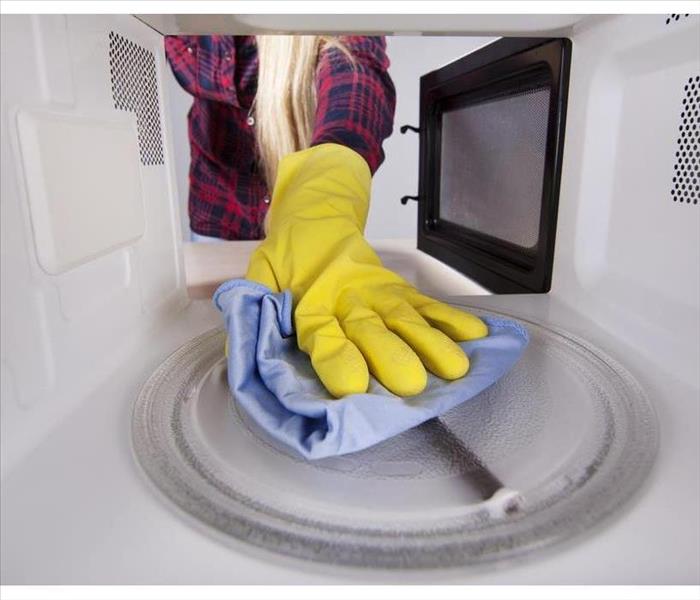 Clean regularly your microwave
Clean regularly your microwave
A dirty microwave is not only gross. It could also spark a fire in your Overland Park, KS, home. If you notice a smoke smell coming from the appliance, it may be time for a cleaning. Other parts of the appliance may need to be replaced entirely.
What To Clean
Cleaning the inside of the appliance is fairly straightforward. All you need is:
- A bowl
- A cloth
- Water
- Vinegar or lemon juice
Start by combing water and vinegar in a bowl. Put the bowl into the appliance and turn on the heat. This should loosen the food from the walls and base. You can then just wipe away the food with a non-abrasive cloth. You may want to use lemon juice instead of vinegar, as the former is particularly effective at removing smoke smell.
The grease filter can get particularly dirty and should be cleaned more frequently. Once a month, let the filter soak in a mixture of detergent and hot water. Then scrub away any remaining debris.
What To Replace
Unlike the rest of the appliance, the charcoal filters cannot be cleaned. If the appliance's hood re-circulates air, you need to change the filters every six months. Replacing the filters is less important if the air ventilates outside the home.
The charcoal filters are often found behind the vent grill. You can buy new filters from the appliance's manufacturer.
The light bulbs inside the appliance should also be replaced whenever they stop working. Your usual manual should provide step-by-step instructions to help you complete this task.
Even if you remove the smoke smell from your microwave, a fire may still occur. Putting the wrong container into the appliance may spark a blaze. That is why you should know the contact information for your local fire damage cleanup company. Restoration experts can get your home back to normal no matter the cause of the flames.
Use This Basic First Aid Advice for Burns at the Workplace
7/6/2020 (Permalink)
 React fast when you get burned by fire damage
React fast when you get burned by fire damage
Potential consequences from fire damage at an Overland Park, KS, commercial location include burn injuries. Your employees or customers can be harmed by fire at any point, so it is important to act appropriately and fast before the burn escalates and severely affects the victim. Use this first aid advice to identify the type of burn and treat it correctly.
Signs of Minor and Major Burns
Minor and major burns are different injury types that require specific treatments. You may be dealing with a minor burn if the following signs are present:
- Pain
- Blisters
- Superficial damage
- Sunburn-like redness
- No bigger than three inches
While immediate treatment is necessary, it does not require emergency services. However, if the burn is deep and larger than three inches, causes the skin to be dry and leathery and contains brown, black or white patches, it is a major burn. You will need to call 911 right away.
Minor Burn Treatment
Sometimes, the only results from a minor incident are some fire damage and minor burns. While an immediate response is needed for someone who suffers these injuries, it does not require calling emergency services. Reduce the pain by applying a wet, cool compress or running it over water. After that, gently remove any present jewelry and apply an aloe vera lotion to stop drying. Avoid breaking the blisters and apply antibiotics if you do. Finally, cover the affected area with a sterile bandage to protect it.
Major Burn Treatment
Keep 911 information at hand, alongside other important contact information like insurance and emergency remediation services. After calling, mitigate the injury with burn first aid while you wait. As before, remove the jewelry and other areas by the affected area carefully and cover it with a cool cloth or bandage. Avoid submerging it with water, as it can cause hypothermia. Elevate the injury and watch for signs of shock and breathing shortage.
It is important to react fast after anyone gets burned following fire damage. Follow first aid procedures to ensure the injury heals properly.
Johnson County Residents need Soot and Smoke Cleanup!
5/25/2020 (Permalink)
Smoke and soot is very invasive and can penetrate various cavities within your home or business, causing hidden damage and odor. Our smoke damage expertise and experience allows us to inspect and accurately assess the extent of the damage to develop a comprehensive plan of action.
Smoke and soot facts:
- Hot smoke migrates to cooler areas and upper levels of a structure.
- Smoke flows around plumbing systems, seeping through the holes used by pipes to go from floor to floor.
- The type of smoke may greatly affect the restoration process.
Different Types of Smoke
There are two different types of smoke–wet and dry. As a result, there are different types of soot residue after a fire. Before restoration begins, SERVPRO of Leawood/Overland Park will test the soot to determine which type of smoke damage occurred. The cleaning procedures will then be based on the information identified during pretesting.
Here is some additional information:
Wet Smoke – Plastic and Rubber
- Low heat, smoldering, pungent odor, sticky, smeary. Smoke webs are more difficult to clean.
Dry Smoke – Paper and Wood
- Fast burning, high temperatures, heat rises therefore smoke rises.
Protein Fire Residue – Produced by evaporation of material rather than from a fire
- Virtually invisible, discolors paints and varnishes, extreme pungent odor.
Our Fire Damage Restoration Services
Since each smoke and fire damage situation is a little different, each one requires a unique solution tailored for the specific conditions. We have the equipment, expertise, and experience to restore your fire and smoke damage. We will also treat your family with empathy and respect and your property with care.
SERVPRO of Leawood/Overland Park has been helping families and businesses throughout the Northland with their cleanup and restoration needs for over 15 years.
Have Questions about Fire, Smoke, or Soot Damage?
Call Us Today – (913) 381-6550
Teaching Kids How to Escape a House Fire
2/26/2020 (Permalink)
 Keep children away from cooking areas
Keep children away from cooking areas
It's hard to think of many more dire emergencies than a house fire. This would be a frightening ordeal for anyone, especially for parents with young children. Kids safety is critical during these moments, so make sure you have an escape plan for your family. If your kids know how to safely get out during a fire, you can rest easy at night and have peace of mind.
Talk About Fire Safety
Before you teach your children home to get out of a home fire, it may be helpful to go over some fire prevention ideas. If people in your house are conscientious and careful in the first place, you may never have to worry about this situation. Talk to your kids about these ways to reduce fire risks:
- Do not play with matches or lighters.
- Keep flammable materials away from stoves and fireplaces.
- Do not try to move candles.
Identify Exits
Your children need to know where to get out of your Prairie Village, KS, home if a fire starts. Kids safety should include showing children to the closest exit to their bedroom and other common rooms in the house.
Talk About Knowing Where the Fire Is
Show your children how to feel doors for the heat of a fire. This will help ensure that they do not exit their bedroom if it is unsafe. Kids should also know about keeping low to the ground, away from harmful smoke.
Develop a Plan and Go Over It
As a family, you should establish a fire escape plan. Draw out escape routes and choose a meeting place safely away from the house. Practice this plan at least once a year so everyone feels comfortable with the process. Time yourself so your kids can do it quickly.
You never want to place a call to a professional fire cleanup crew to restore your house after a fire. Still, if a fire does start, you can feel good knowing you have practiced kids safety and that your family knows how to safely exit your house.
Does Insurance Cover the Cost of Fire Damage Restoration Services?
11/22/2019 (Permalink)
 It is always a good idea to speak to your insurance agent ahead of time and find out the specifics of what your policy covers
It is always a good idea to speak to your insurance agent ahead of time and find out the specifics of what your policy covers
Does Insurance Cover the Cost of Fire Damage Restoration Services?
Whether your home in Overland Park, KS, has recently experienced a large blaze that claimed most of your belongings or a small ignition that quickly got put out, the cost of addressing damage caused by a home fire can be overwhelming. Here is some useful information on how much fire damage cleanup services typically cost and what your insurance plan should cover.
How Much Does Fire and Smoke Cleanup Cost?
On average, the overall cost for cleanup services after a home fire is between $3,177 and $7,863. To come up with an estimate, you need to consider the extent of the damage. There are several factors that have a high impact on the final amount:
- Damage to the structure of your home
- Presence of soot on belongings
- Apparent smoke damage
- Water damage from a fire hose or broken pipe
- The need for odor removal services
Will Insurance Cover the Cost?
Most standard homeowners insurance plans provide some level of coverage for remediation after a fire, except for two situations. If it is determined that the cause of the fire was insurance fraud arson, you will not receive coverage and will likely face criminal prosecution. Additionally, you will not be covered if the house has not been lived in for over 30 consecutive days, which is considered a vacant home fire.
What Does Insurance Cover?
While every policy is different, homeowners insurance often covers the cost of repairing your home in addition to other structures located on your property. Additionally, your personal belongings should be covered, but you need to ask if your policy pays the fair market value of items lost or the replacement value.
While remediation services after a home fire can be extremely pricey, you can have peace of mind knowing insurance covers most types of fire damage. It is always a good idea to speak to your insurance agent ahead of time and find out the specifics of what your policy covers.
The Benefits of an Emergency Board Up After a Fire
10/30/2019 (Permalink)
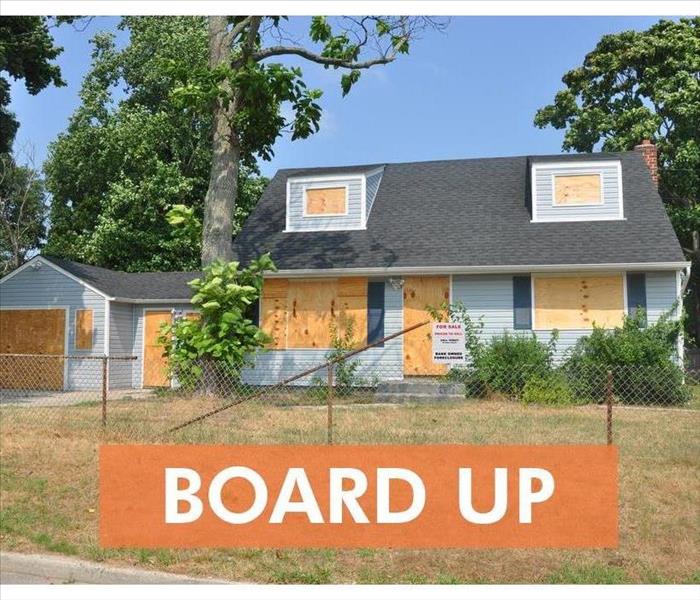 Boarded up home after a fire in Prairie Village, KS
Boarded up home after a fire in Prairie Village, KS
After your house in Prairie Village, KS, has gone through a dangerous fire, it is common to cover some parts in a practice known as an emergency board up. In a board up, professionals place boards over damaged and vulnerable windows, doors and other weaker parts of the house. While you might be tempted to overlook this option, it can provide multiple benefits to the survival of the building.
Protection Against Further Damage
The fragile position of the damaged home can make it vulnerable to multiple hazards and risk factors.
- Strong winds
- Rain and storms
- Intrusion by wildlife
- Trespass by humans
- Other environmental conditions
Boarding up the house prevents the fire damage from escalating, also reducing the work performed by fire cleanup specialists. Some companies even offer these services as part of the restoration process.
Prevention of Insurance Loss
After a devastating home fire, one of the first actions you might take is calling the insurance company. While you might receive coverage for the fire, companies look for any reason to drop coverage if the homeowner does not make effort to stop the damage. In fact, some insurers even require tarp over and board up for the affected residence. Avoid the additional trouble and request this practice to decrease the destruction and keep your insurance coverage.
Avoidance of Human Intrusion
Even though the burned house is exposed to a variety of risks, human trespass is perhaps the most dangerous one. Intruders can exploit the weakened areas as entry points and either rob the area or vandalize and increase the damage. Additionally, if someone gets injured during a stay in the house, you could be held liable, even if they broke into the place. Emergency board up resolves this potential problem.
Even if a home is greatly destroyed, a board up can play a significant role in its restoration. This practice can protect your home from increased damage, ensure your insurance coverage and stops criminals from breaking in.
What Happens When Lightning Strikes Your Home
7/19/2019 (Permalink)
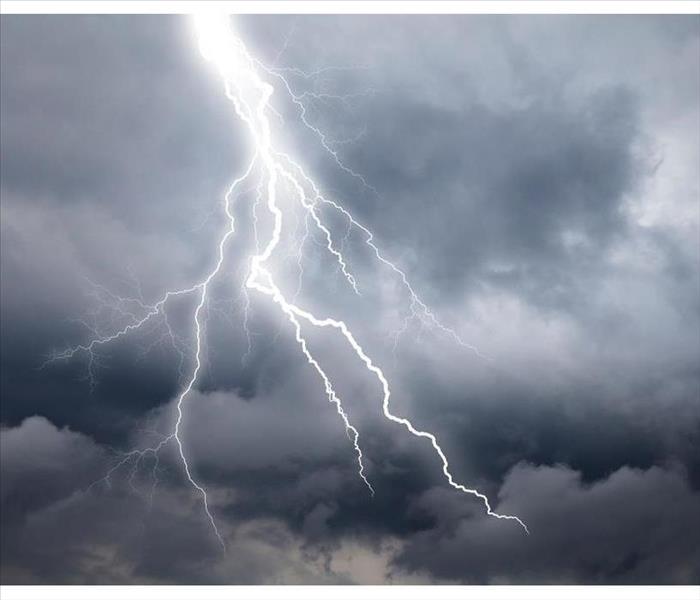 Lightning is a part of nature and beyond your control
Lightning is a part of nature and beyond your control
What Happens When Lightning Strikes Your Home
Between 2007 and 2011, the National Fire Protection Association estimates that U.S. local fire departments responded to an average of 22,600 house fires caused by lightning. During these years, lightning fire caused an estimated $451 million in direct property damage. Only about 18% of these fires occurred in homes but this accounted for 70% of the total property damage. There is always a chance that when a storm comes through your area, damage to your home can result. Effects of a strike could cause both a power surge and fire.
Power Surge
A power surge from a lightning strike occurs when the energy courses through the home’s wiring system. The upwelling of force can also affect the plumbing. The current runs throughout the house causing damage to electronics such as TVs, computers and possibly your alarm and Wi-Fi systems.
Fire
A lightning fire is a definite possibility. The strike will usually pass through the roof and into the attic causing the insulation and the structure to burst into flames. There is also a chance that a power surge going through the wiring in your walls can cause a spark which will turn to fire. If you see fire or smell smoke, leave the house immediately. Call 911 and let the fire department in Overland Park, KS, do a check of the property.
Lightning is a part of nature and beyond your control. However, protecting your home and your family from a lightning fire is doable. As a preventive measure, when a storm rolls through, protect your valuable electronics by unplugging everything which could be affected. Also, you can use lightning rods as a means of shielding the home. The rod is attached to the highest point of the house and conducting wire leads from the rod to the ground directing the hit away from the structure. Although you cannot totally prevent a lightning fire from occurring, be proactive in speaking with a fire restoration specialist.
Preparation Is Important When Filing an Insurance Claim for Fire Damage
6/28/2019 (Permalink)
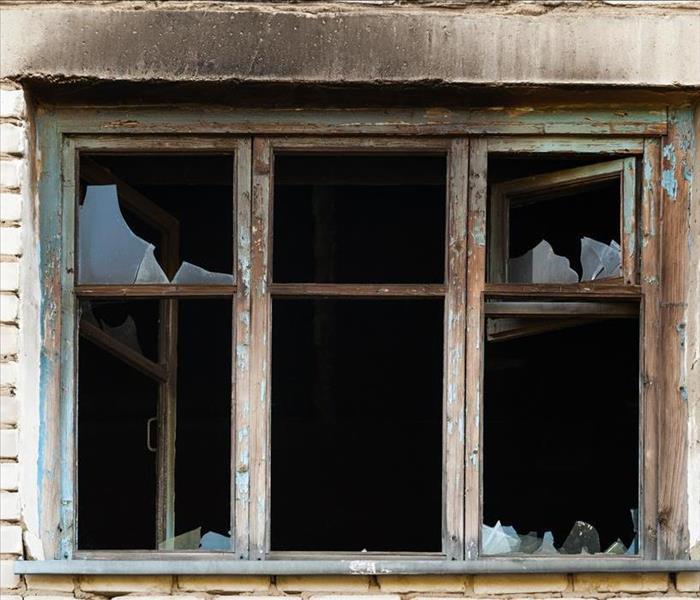 Broken windows after fire damage
Broken windows after fire damage
If the worst happens and your commercial property experiences a fire, you should act to file a fire claim as quickly as possible. To keep the process smooth and ensure that you are receiving full coverage, there are several steps you can take to keep your insurance company happy in Prairie Village, KS.
Secure the Property
Once the fire trucks are gone and the fire has died, you will want to keep the fire damage from getting worse. However, only do what you feel comfortable with, and if a situation feels unsafe you should leave it to the professionals.
If certain areas have been exposed or the windows have blown out, try to board them up as best you can.
If part of the roof is gone, it is a good idea to tarp it up to prevent rain and other elements from entering.
If pipes are burst you should shut off the water.
Gather Your Records
So you aren't left scrambling later, you should gather all documents relevant when assigning value to items that have been damaged or lost. You should keep a record of all expenses incurred from the moment the fire started. It is best practice to photograph all the damage, even before you start securing your property. Making a fire claim is even easier if you also take the initiative to get estimates for all your repairs.
Get Ready for a Visitor
Typically insurance companies will send one or more claims adjusters with specialized knowledge to investigate the claim and assess various forms of damage in order to determine your coverage. They may keep in touch in order to receive updates on the fire restoration process and make payments to your account. Payments are usually sent via direct deposit or check.
When making a fire claim to your insurance, the more information you have at the ready, the easier it will be for everyone involved. This will also make it more likely that you get adequate coverage. Going through a disaster is tough, there's no reason to make it tougher.
Reduce the Risk of Cigarette Fire in Your Home
5/22/2019 (Permalink)
 Never leave a lit cigarette unattended
Never leave a lit cigarette unattended
There are many reasons a house in Leawood, KS can catch fire and it can be a devastating experience. Lightening strikes, electrical malfunctions or sparks from a nearby chimney are unexpected and traumatic. However there are also many types of fires can be prevented. A cigarette fire is one of those. If you or someone in your home enjoy smoking, it is vital to take the necessary precautions to prevent the outbreak of a blaze.
Tips for Safer Smoking
- Make sure to keep sturdy ashtrays in several places in the home, always on a solid surface, never the arm of a chair or the bed. Better yet, smoke outdoors.
- Never leave a lit cigarette, cigar or pipe unattended. It only takes seconds for a fire to break out. This is especially important if there are pets or children in the home.
- Make sure any used matches or butts are completely extinguished before throwing away. Take them out to a sand-filled pot outdoors, not in the trashcan.
- Do not smoke when sleepy or in bed; a cigarette fire can easily happen when you fall asleep
- Never light a cigarette or smoke in the presence of oxygen, as it is highly combustible
Cigarette and ashtray fire is the leading cause of home fire deaths each year. The majority of these fires begin in a chair, a bed or a trashcan, which can ignite quickly, and often when the smoker has fallen asleep or become distracted. Again, smoking outdoors is preferable, both for fire prevention and for more breathable air inside the home.
As the home of a smoker can be at a higher risk of fire, prepare your family in advance to be safer. Discuss evacuation plans and practice escape routes. Decide on a local fire restoration service in Leawood, KS to help with fire cleanup and have their number at hand. Taking the necessary precautions against cigarette fire can help you feel more at ease.
How To Prepare for a Home Fire When You Have Pets
2/5/2019 (Permalink)
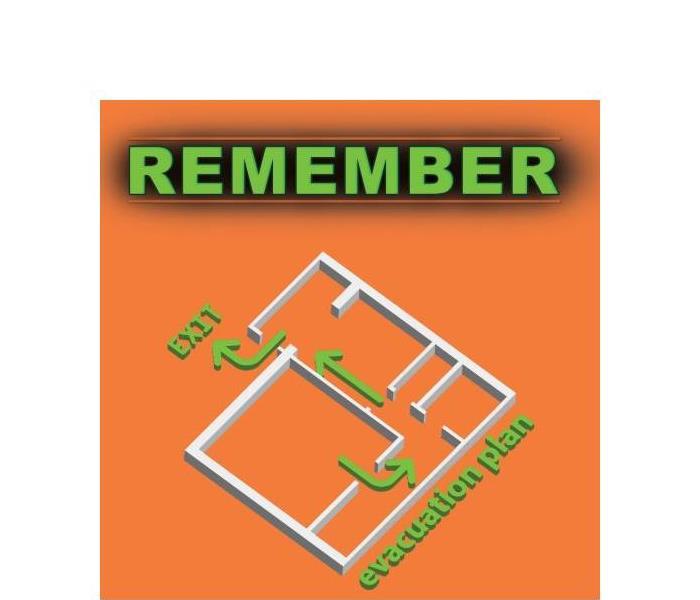 Remember to include your pet in your fire escape plan
Remember to include your pet in your fire escape plan
How to Prepare For a Fire Emergency
The thought of a fire in your home in Overland Park, KS can be scary, especially if you have pets. However, being prepared for the worst can help you react appropriately if a fire emergency does occur.
1. Take Precautions
Although not all fires are preventable, it’s often wise to do what you can to prevent a fire from occurring in your home by focusing on pet safety. If your pets roam around the house while you are away, making sure to keep away potential fire hazards out of reach from your pets can be helpful. Since not all fire hazards can be easily moved, it’s often best to keep pets in an area where they do not have access to potentially dangerous items while you are out of your house.
2. Make a Plan
Knowing how to react in the event of a fire emergency is important for everyone, but it’s especially important when you have pets. Make a plan of escape and know how to escape your home if your first route of escape is blocked off. After you have a plan, it’s useful to frequently practice this plan. If a fire does occur, having a plan in place can save you time and energy and can ultimately keep you and your pets safe.
3. Prepare Documentation
Part of pet preparation involves updating documents about your pets and keeping them in a fire-resistant container. If your pet does need veterinary care after a fire, having all of your pet’s documents in one place can save you a great deal of stress. Additionally, placing a sticker on a window at the entrance of your home that includes the number of pets in your home can be beneficial for firefighters when entering your home.
Taking steps to prevent a fire from occurring, making a fire escape plan and preparing documents that pertain to your pets can help you prepare for a fire. If a fire emergency has affected you and your home, it may be useful to contact fire damage restoration experts.
3 Ways To Clean Contents After a Fire
1/11/2019 (Permalink)
 Soot damage in Overland Park, KS
Soot damage in Overland Park, KS
3 Ways To Clean Contents After a Fire
Even without catastrophic structural damage, a fire can wreak havoc on your property. From smoke damage, to water damage from firefighting efforts, there’s a surprisingly long list of ways that fires create a mess. The good news is there are lots of options for cleaning up your content, from elaborate fire restoration to simple dry-cleaning. Here are a few of the ways you can get your Overland Park, KS, property back to normal.
Fire damage typically evokes thoughts of broken windows and burnt through roofs. But fire damage also often includes:
- Smoke damaged clothing and personal property
- Water logged carpets and furniture
- Soot stained upholstery and carpeting
And that’s just for starters. Fortunately, there are professionals there to help.
Dry-Cleaning
This simple process is one of the easiest ways to handle smoke damage. Drapes and other fabrics can be dry cleaned in place to remove the pervasive smell of smoke, soot and burned goods as well as getting rid of stains. Be sure to choose a fire restoration or textile restoration company that specializes in fire damage for the best results.
Fire Remediation
This typically involves removing water - an important part of ensuring your business is safe for use. Water that gets beneath carpet pads and festers in walls can become a breeding ground for mold. Fire remediation firms use suction devices and industrial dryers to get rid of every drop.
Cleanup Services
Typically offered as an add on to remediation, cleanup services focus more on cleaning, deodorizing and restoring personal property. This can include spray and wipe cleaning, foam cleaning, abrasive cleaning, immersion and much more.
Cleaning up plays a big part of getting back to normal after a business fire. Fortunately, it’s not something you have to tackle yourself. Contract with experts in dry-cleaning, content storage and other fire content cleaning and your property will be as good as new.
Smoke Alarms: Maintaining Performance
12/26/2018 (Permalink)
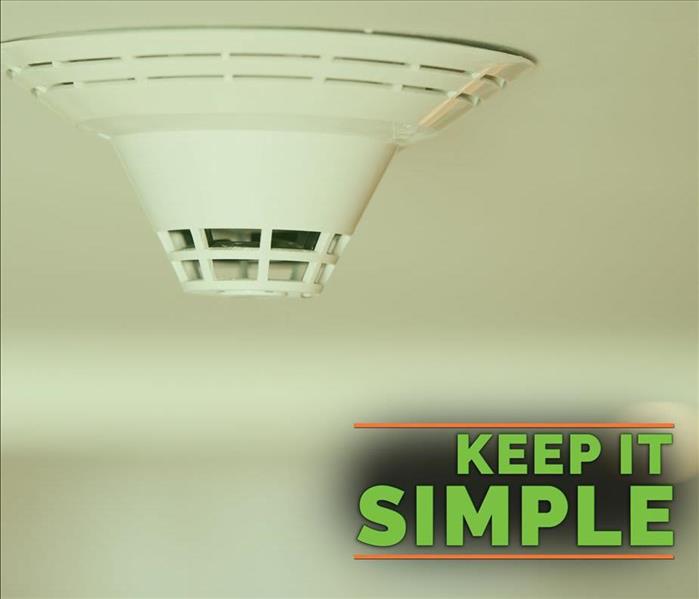 Contact a fire remediation specialist in the Leawood, KS area to get your alarm installed
Contact a fire remediation specialist in the Leawood, KS area to get your alarm installed
Smoke Alarms: Maintaining Performance
A smoke alarm may be the last defense you have to ensure that you and your family are safe in a disaster. Therefore, it is vital that all your alarms are correctly installed and regularly tested. If you are not confident in your ability to install these items, you can call a fire remediation specialist in the Leawood, KS, area who may be able to assist you. Beyond installation, you will want to ensure that you are maintaining you alarms appropriately. Depending on your chosen detectors, the maintenance schedule can vary.
1. Nine-Volt Battery Powered Detectors
As an affordable smoke detector option, nine-volt powered detectors will require monthly inspections and tests, you should make sure that the alarm is clean and free of debris, and you should test the signal by pressing the test button. Also, you should replace the batteries annually to ensure proper functionality. Additionally, it is recommended that you replace these alarms every 10 years.
2. Long-Life Alarms
A long-life smoke alarm typically refers to detectors that use a 10-year lithium battery. As these batteries should not be replaced, it is recommended that the entire unit is replaced in accordance with the manufacturer’s guidelines. However, you should test the alarm and ensure it is free of cobwebs and dust at least once per month.
3. Hardwired Fire Signals
Hardwired fire signals are connected directly into your homes electrical system, which provides an added sense of security because the units can communicate with each other, sounding alarms throughout the residence. This type of alarm should be tested monthly and replaced every 10 years. Additionally, the battery backup should be replaced annually.
Fire damage is one of the worst fears of many homeowners because of the risk to their property and the potential loss of life. A smoke alarm provides reassurance because it can alert and thereby protect a home’s inhabitants. However, depending on the type of alarm, each signal requires a certain amount of upkeep to maintain performance.
5 Tips To Prevent Kitchen Fires
7/16/2018 (Permalink)
In 2016, 50% of house fires in the United States were caused by cooking. As a homeowner in Overland Park, KS, follow these five helpful tips to reduce the chance of fire damage in your kitchen:
1. Pay Attention.
Be attentive to your cooking and do not leave it unattended, even for a few minutes. If you must leave the house, turn off the oven first. Regularly check on the food, especially if you are frying, broiling or grilling. If you are not in the kitchen, set a timer so you know when the food is done. Double check that appliances are turned off before heading to bed.
2. Reduce Fire Hazards.
Move anything that is flammable away from heat sources in the kitchen, especially those that generate open flames. This includes dish towels, pot holders, grocery bags and long sleeves or hair when cooking.
3. Clean Surfaces.
Over time, grease and oil residue build up. Regular cleaning is one of the best tips to prevent a grease fire. If a grease fire occurs, never put water on it. Rather, cut off the oxygen to the flames by covering it with a pot or pan.
4. Take Precautions.
The kitchen is no place for small children while you are cooking. Teach your kids to stay at least three feet away from the oven for safety.
5. Be Prepared.
Protect your home by installing a working smoke detector in or near your kitchen, and on all levels of your home. Check the batteries and test the device on a regular basis. Keep a fire extinguisher within reach to combat small fires in early stages.
Follow the above tips to decrease the risk of fire in your home. Sometimes even taking precautions cannot prevent a fire in Overland Park, KS. If this happens, immediately get your family to safety and call the fire department. After the blaze is out, contact a fire restoration specialist and your homeowner’s insurance agent to learn about your next steps to restore your fire damaged home.
For more information, please visit us at http://www.SERVPROleawoodoverlandpark.com/.

 24/7 Emergency Service
24/7 Emergency Service




















